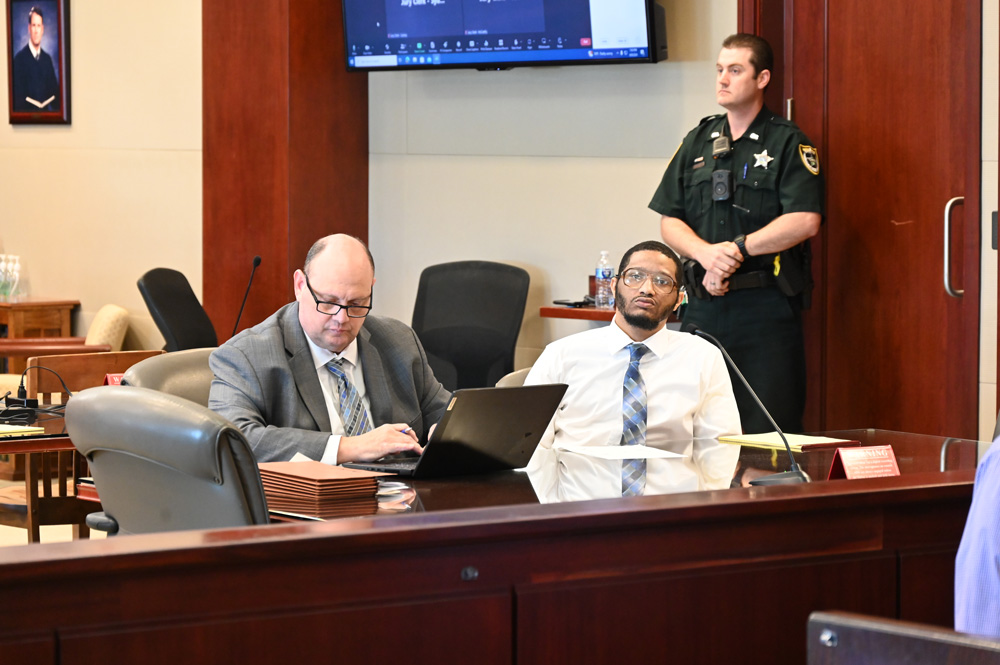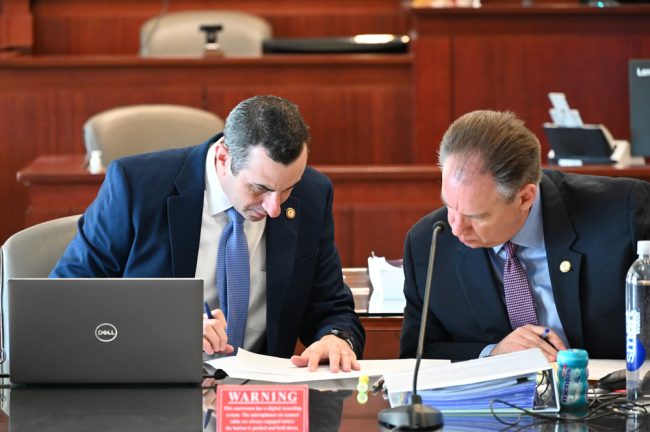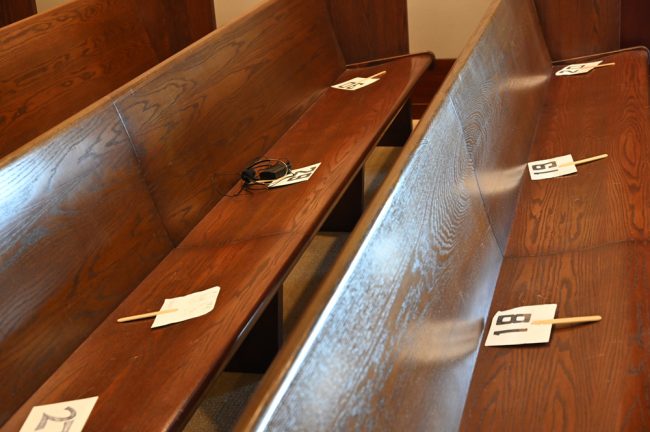
After an afternoon eclipse break that could be anyone’s omen, jury selection in the trial of Marcus Chamblin on murder and attempted murder charges ended today with the seating of a 12-member panel, plus two alternates–10 women, four men, three of the jurors Black.
Chamblin’s attorney early in the selection process resisted the prosecution’s attempts to too liberally weed out Black jurors: his client is Black.
Chamblin, 29, faces a first-degree murder charge in the shooting death in October 2019 of 25-year-old Deon O’Neil Jenkins at a Palm Coast Circle K and the wounding of Shakir Terry, now 31. The death penalty is not an option. But Chamblin faces life in prison if convicted. Derrius Bauer goes on trial on the same charges in September.
Chamblin turned down so much as discussing a plea offer: Assistant State Attorney Mark Johnston, who is prosecuting the case with Assistant State Attorney Jason Lewis, told Circuit Judge Terence Perkins this morning that while “nothing specific” was offered. But when Johnson approached Terence Lenamon, Chamblin’s attorney, he was told that Chambling was “not willing to discuss anything, and so he wants a trial.”
Perkins himself tried asking Chamblin directly: “Is there any offer you want to communicate to the state?” he asked him. “No, sir,” Chamblin replied. It was the first time in three years and three months–the length of his incarceration at the Flagler County jail since his arrest–that Chamblin wore civilian clothes, as trial defendants do so that the jury is not prejudiced against them by their jail or prison garb–what would be a loud, orange suit with the wrist and leg chains visibly clanging on the outside.
Chamblin had no manacles this time, and the jury could not see the metal leg brace corrections officers place under his pants to minimize his movements. He’d done what defendants usually do for trial: trimmed what had previously been a more pronounced, and a literally more pointed, beard.
For the rest of the day Chamblin sat next to Lenamon, clearly interested in the proceedings. Not all defendants are. Some defendants can seem overeager during jury selection, dictating directions in their attorney’s ear. There seemed to be little interaction between Lenamon and his client, even during breaks, even when it came time for striking out jurors and selecting favored ones at the end of the day. Chamblin was his own, quiet sidebar of one throughout.

The jurors were culled from a pool of 50 that by lunchtime had been reduced to 41: eight had been excused for reasons as varied as an immovable but essential appointment with a hygienist to a juror’s antipathy for police officers (“I won’t believe him,” she said of any witness who’d wear a cop’s uniform) to an overeager former corrections officer of many years who admitted that he “probably” would not be impartial toward the defendant. Beside, he had tickets to fly to Kentucky during trial week. “The ark experience,” he told the judge of the Ark Encounter fantasy park in Williamstown, Ky., where the size of Noah’s mythological ark is much bigger than any acknowledgement of empirical evidence.
Also excused was a juror who’d been a former graduate of the judge’s own drug court–and a current professional success and poster child of the program’s potential wonders. She simply said she “won’t be able to sit” through the trial, once she heard the allegations, and judged, correctly, that there would have to be horrific pictures to look at: Jenkins and Terry were sitting in a Chevy Malibu at the Circle K parking lot on Palm Coast Parkway and Belle Terre Parkway around 3:30 a.m. on Oct. 12, 2019 when someone darted behind the car and fired at least 16 rounds from an AK-47-like Draco firearm, then fled. At least that’s how many casings sheriff’s deputies recovered.
Jenkins had been sitting in the passenger seat, the side from where the shooter had fired. One of the bullets pierced Jenkins’s heart. Terry was shot in the arm and the leg. Half an hour earlier (surveillance video later showed), Jenkins was shaking hands outside the Circle Ka with Derrius Bauer, Chamblin’s co-defendant.
Perkins told the potential jurors that they would in fact have to look at pictures.

Those chosen include no fewer than three postal workers (one of them retired), a restaurant manager, a dental-lab technician, a nurse practitioner, a medical office receptionist, a banker, a retired disabled veteran, a couple of customer service specialists, a retired accountant, a small-business owner, and a veterinary technician.
A couple of lawyers were among those who, typically in jury selection, didn’t make it–the lawyers on the other side of the bar don;t like the competition– as was a physician who’d once been a cop and called it “one of the best experiences I ever had.” The prosecution had been willing to have the physician serve as an alternate. It was down to the wire, after all: there was only one juror left who could fill the slot. The defense struck the formerly happy cop.
The attorneys’ questions or comments to the potential jurors reveal much of the themes they’ll be hewing to during the trial. Firearms, of course, will play a central role. When Johnson asked who owned firearms among the 41 jurors left in the pool after lunch, 18 hands went up, and when Johnson took a census of the number and types of firearms those 18 had under their roof, the resulting arsenal, including a disturbing number of AR-15s, the assault rifle its owners like to pretend is a mere firearm like any other, was enough to arm a mercenary expeditionary force. To a juror, the respondents said the weapons were for self-defense, and to shoot at the range, with one exception, who called hers a “paperweight” that had not been fired in years.
“My husband owns two AR-15s just to have it, because it’s Florida,” one juror said. She had never fired either. “They look intimidating to me now. I’m going to go try one day.” Four of the 18 jurors who’d spoken of having guns in their home were chosen.
The prosecution also wanted to make sure that jurors understood the meaning of “circumstantial evidence,” summing up in those two words what the state’s case is going to hinge on.
Lineman kept his portion of jury selection to a few minutes. Going last, he had the benefit of the judges’ hours of questioning and Johnson’s hour. One of the questions he asked the jurors is whether they will consider that witnesses may have been offered money or preferred treatment to testify. The jurors all said they would, though those ploys tend to hint at their own sort of circumstantial desperation than more authentic deconstruction of evidence.
A minute after 3 p.m., and before the lawyers had had their turn, Perkins said: “Ladies and gentlemen, it’s eclipse time.” The eclipse was peaking right about then. Jurors rushed the exit, most oof them having wanted to be outside just then. They were given 20 minutes. Perkins himself used a trick he learned in 3rd grade, drilling a hole in a piece of paper to have a look at Helios’s half-wink (the eclipse only reached 61 percent obscurity in Bunnell). Others had eclipse glasses as they gazed into the hazy sky from the plaza in front of the courthouse. Chamblin was not allowed out.
Opening arguments are set for a little after 9 a.m. in Courtroom 401 Tuesday. The judge has reserved six more days of trial, running into next week.
![]()




























Leave a Reply